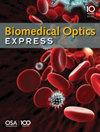CRISPR/Cas12a 裂解触发纳米花,用于太赫兹频率下无荧光和无靶标放大的 ctDNA 生物传感。
IF 2.9
2区 医学
Q2 BIOCHEMICAL RESEARCH METHODS
引用次数: 0
摘要
液体活检中肿瘤生物标记物的检测需要高灵敏度和低成本的生物传感策略。然而,很少有传统技术能同时满足无目标扩增和无荧光的要求。在这项研究中,我们提出了一种结合太赫兹光谱和 CRISPR/Cas12 系统的新型 ctDNA 检测策略。CRISPR/Cas12a 系统被目标 ctDNA 激活后,会发生一系列反应,形成金-铁复合物。这种复合物很容易用磁铁提取出来,当滴入到太赫兹超材料传感器上时,它可以增强频移,从而提供对目标ctDNA的灵敏和选择性传感。结果表明,所提出的太赫兹生物传感器的检测限相对较低,仅为 0.8 fM,而且对干扰物种具有良好的选择性。与使用太赫兹波的传统生物传感方法相比,这一检测限提高了三个数量级。此外,在牛血清中成功检测到 100 fM 的 ctDNA 浓度(相当于最终反应体系中的 50 fM),而无需扩增。本文章由计算机程序翻译,如有差异,请以英文原文为准。
CRISPR/Cas12a cleavage triggered nanoflower for fluorescence-free and target amplification-free biosensing of ctDNA in the terahertz frequencies.
The detection of tumor biomarkers in liquid biopsies requires high sensitivity and low-cost biosensing strategies. However, few traditional techniques can satisfy the requirements of target amplification-free and fluorescence-free at the same time. In this study, we have proposed a novel strategy for ctDNA detection with the combination of terahertz spectroscopy and the CRISPR/Cas12 system. The CRISPR/Cas12a system is activated by the target ctDNA, resulting in a series of reactions leading to the formation of an Au-Fe complex. This complex is easily extracted with magnets and when dropped onto the terahertz metamaterial sensor, it can enhance the frequency shift, providing sensitive and selective sensing of the target ctDNA. Results show that the proposed terahertz biosensor exhibits a relatively low detection limit of 0.8 fM and a good selectivity over interference species. This detection limit is improved by three orders of magnitude compared with traditional biosensing methods using terahertz waves. Furthermore, a ctDNA concentration of 100 fM has been successfully detected in bovine serum (corresponding to 50 fM in the final reaction system) without amplification.
求助全文
通过发布文献求助,成功后即可免费获取论文全文。
去求助
来源期刊

Biomedical optics express
BIOCHEMICAL RESEARCH METHODS-OPTICS
CiteScore
6.80
自引率
11.80%
发文量
633
审稿时长
1 months
期刊介绍:
The journal''s scope encompasses fundamental research, technology development, biomedical studies and clinical applications. BOEx focuses on the leading edge topics in the field, including:
Tissue optics and spectroscopy
Novel microscopies
Optical coherence tomography
Diffuse and fluorescence tomography
Photoacoustic and multimodal imaging
Molecular imaging and therapies
Nanophotonic biosensing
Optical biophysics/photobiology
Microfluidic optical devices
Vision research.
 求助内容:
求助内容: 应助结果提醒方式:
应助结果提醒方式:


